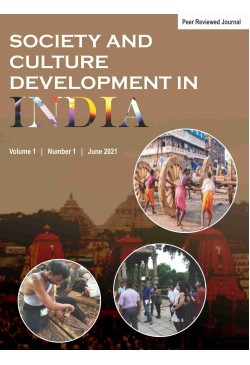
Society and Culture Development in India
Frequency :Bi-Annual
ISSN :2583-0694
Peer Reviewed Journal
Contents and Editorial Note
Micro-Finance Posing Double Burden on the Poor Women
This research paper reveals the impacts of micro-credits on the poor women. Since the last three and half decades, macro-credit policy has been working as policy of providing micro-finance to the poor sections of the society in general and women in particular. However, the results and impacts of micro-credits are varied across the countries, states and regions. The most of the studies pointed out the economical aspects and micro-credits impacts on women enterprises and income generating activities. Hence, there is little efforts had made to focus on the socio-cultural impacts of the micro-finance on the individual life of women. Thus, there is scope for in searching the truth and realities faced by micro-credit beneficiaries. The existing study has lacunas to explore the personal experiences, narratives and views of the micro-credit beneficiaries. Thus, there is need to explore the personal, individual lived stories and experiences of women in detail. Therefore, this study has major aim to access the impacts of micro-credits policies on daily routine life of the women. As we know that women have to play multiple roles in the private spheres of the life, such as; cleaning, nurturing, washing, cooking and all types domestic works. In addition to existing burden, micro-credits are posing additional burdens of the work of income generating activities; repay the loan and interest rate in time on women. However micro-credit is offered credits, trainings and linkages with banking and markets to women on the one hand. But, on the other hand, women are centered and liable to repay the loan and interest to the micro-credit agencies. All micro-credits are providing loans only to the women members because of the women’s liability and trusts. As result of this, women are responsible to repay the loan in time. Being lender, she is always under the mental and physical trace and burden to repay the loan. Against this backdrop, this study will look into the ground realities of micro-credit beneficiaries of Rural Maharashtra and its impacts on the poor women. How women are negotiating with the caste, patriarchy and male-dominance and culture. How, she is adjusting with the double roles as care takers and earners. Is she under double burden of micro-credit? How she is negotiating with the different stakeholders?.
Keywords: Micro-credits, Burden, Bellow Poverty Line Poor and Women
NEP 2020 and Transgender Communities’ Education: A Transformative Approach or Missed Opportunity?
Mathew, G.S. (2023). NEP 2020 and Transgender Communities’ Education: A Transformative Approach or Missed Opportunity?, Society and Culture Development in India, 3: 1, pp. 195-206. https://doi.org/10.47509/SCDI.2023.v03i02.02
Pando Tribe in Contemporary Society
Continuity and Change in the Traditional Weaving Method: A Study of Women Weavers of Mima Village
Digital Fatigue and Mental Health: Exploring the Correlation Between Increased Screen Time During the COVID-19 Pandemic and Its Impact on Mental Well-being Among the Youth of Uttar Pradesh
Singh, P., & Pathak, S. (2023). Correlation between Increased Screen Time During the COVID-19 Pandemic and its Impact on Mental Well-being Among the Youth of Uttar Pradesh, Society and Culture Development in India, 3: 1, pp. 235-247. https://doi.org/10.47509/SCDI.2023.v03i02.05
Gender Bias in Mobile Phone Usage: A Case Study of Mukhra Village
Fertility, Morbidity and Mortality Trends along with Health Seeking Behaviour among Kondh and Porja PVTGs in Munchingput mandal of Visakha Agency in Andhra Pradesh
Rao, S.N. (2023). Fertility, Morbidity and Mortality Trends along with Health Seeking Behaviour among Kondh and Porja PVTGs in Munchingput mandal of Visakha Agency in Andhra Pradesh, Society and Culture Development in India, 3: 1, pp. 261-276. https://doi.org/10.47509/SCDI.2023.v03i02.07
History of the Satnami Community of Chhattisgarh: A Review of Literature
Manjre, S.K., & Ambewadikar, J. (2023). History of the Satnami Community of Chhattisgarh: A Review of Literature, Society and Culture Development in India, 3: 1, pp. 277-289. https://doi.org/10.47509/SCDI.2023.v03i02.08
Towards Social Innovation in Improving Life of Rural People in India
Rana, U. (2023). Towards Social Innovation in Improving Life of Rural Peopld in India, Society and Culture Development in India, 3: 1, pp. 291-299. https://doi.org/10.47509/SCDI.2023.v03i02.09
ASHA Workers in India: A Quest for Socio Legal Identity